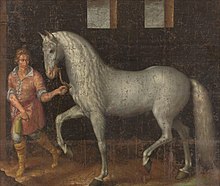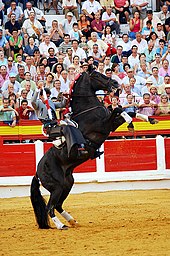Lusitano
 A Lusitano horse | |
| Other names | Portuguese horse, Peninsular horse, Betico-lusitano |
|---|---|
| Country of origin | Portugal |
| Traits | |
| Distinguishing features | Convex profile, powerful neck and hindquarters, high-stepping gait |
| Breed standards | |
The Lusitano, also known as the Pure Blood Lusitano or PSL (Puro Sangue Lusitano), is a
Lusitanos can be any solid
History
Horses were known to humans on what is now the

When the
Prior to modern times, horse breeds throughout Europe were known primarily by the name of the region where they were bred.[9] The Lusitano takes its name from Lusitania,[9] an ancient Roman name for the region that today is Portugal. A very similar horse, the Spanish Andalusian, originally described the horses of distinct quality that came from Andalusia in Spain.[10] Some sources state that the Andalusian and the Lusitano are genetically the same breed, and the only difference is the country in which individual horses are born.[11] The Lusitano is also known as the Portuguese, Peninsular, National or Betico-lusitano horse.[12]

During the 16th and 17th centuries, horses moved continually between Spain and Portugal, and horses from the studs of Andalusia were used to improve the Portuguese cavalry. Portugal's successful
Prior to the 1960s, the Iberian-type horse was called the Andalusian in both Portugal and Spain. In 1966, the Lusitano name was adopted by Portugal after a studbook separation by the two countries.
Strains and sub-types
The Portuguese stud book recognizes six horses (five

- Agareno, a 1931 Veiga stallion, out of Bagocha, by Lidador
- Primorosa, a 1927 Dominquez Hermanos stallion, out of Primorosa II, by Presumido
- Destinado, a 1930 Dominquez Hermanos stallion, out of Destinada, by Alegre II
- Marialva II, a 1930 Antonio Fontes Pereira de Melo stallion, out of Campina, by Marialva
- Regedor, a 1923 Alter Real stallion, out of Gavina, by Gavioto
- Hucharia, a 1943 Coudelaria Nacional mare, out of Viscaina, by Cartujano
Alter Real
The Alter Real is a strain of the Lusitano which is bred only at the Alter Real State Stud in Portugal.
In the early 20th century, with the 1910 revolution that ended the monarchy, the Alter Real strain faced extinction, as records were burned, stallions were gelded and the stud discontinued. Ruy d'Andrade, a specialist in Iberian horse breeds, saved two stallions and several mares, and was able to re-establish the strain, turning his herd over to the Portuguese Ministry of Agriculture in 1942, when the stud was reopened.[24] The Portuguese state has maintained ownership of the stud, and continues to produce horses for use in high school dressage.[25]
Registration
Today, outside of Portugal and Spain, breeding, showing and registration of both Lusitanos and Andalusians are often closely linked. One example is the Australasian Lusitano Horse Association of Australasia (LHAA), which shares responsibility for the Purebred Iberian Horse (an Andalusian/Lusitano cross) with the Australasia Andalusian Association,[26] as well as hosting a combined National Show for the two breeds in Australia. The LHAA was formed in 2003 to register and promote the Lusitano breed in Australia and New Zealand, and in June 2005 signed an agreement with their parent organization, the Portuguese Associação Portuguesa de Criadores do Cavalo Puro Sangue Lusitano, to follow that association's rules and regulations. The LHAA maintains two studbooks (for the purebred Lusitano and the purebred Iberian) and a crossbred registry for horses with one Lusitano parent.[27][28] An example of a combined registry is the International Andalusian and Lusitano Horse Association (IALHA).[29]
Characteristics and uses
Lusitanos are generally

The ancestors of the Lusitano were originally used for
They are still used for mounted bullfighting today, in a form where the bull is not killed and it is considered a disgrace to the rider if the horse is injured. Horses bred for this sport must be agile and calm, remaining in the control of the rider even when confronted by a bull.
Notes
- ^ a b c d e f g "Lusitano". International Museum of the Horse. Retrieved 2009-11-13.
- ^ ]
- ^ PMID 16251517.)
{{cite journal}}: CS1 maint: multiple names: authors list (link - ^ d'Andrade, R (1945). "Sorraia". Boletim Pecuário (in Portuguese). 13: 1–13.
- PMID 12130666.)
{{cite journal}}: CS1 maint: multiple names: authors list (link - .
- PMID 16978180.
- PMID 17177696.)
{{cite journal}}: CS1 maint: multiple names: authors list (link - ^ a b Bennett, Conquerors, p. 158
- ^ Bennett, Conquerors, p. 159
- ^ Stephens, Stephanie (July–August 2005). "Dressage:Superlative Alternatives" (PDF). Equestrian: 65–66. Archived from the original (PDF) on 2011-06-17. Retrieved 2009-06-26.
- ^ a b c d "Lusitano". Breeds of Livestock. Oklahoma State University. Archived from the original on 2009-02-16. Retrieved 2009-11-13.
- ^ Loch, The Royal Horse of Europe, pp. 112-113
- ^ Loch, The Royal Horse of Europe, p. 126
- ^ Loch, The Royal Horse of Europe, pp. 95, 127
- ^ a b Edwards, The Encyclopedia of the Horse, p. 107
- ^ Loch, The Royal Horse of Europe, pp. 128-130
- ^ a b "Origins of the Breed". Lusitano Horse Association of Australasia. Retrieved 2010-01-18.
- ^ "Lusitano Lineages in Portugal". Lusitano Horse Association of Australasia. Retrieved 2010-01-18.
- ^ Draper, The book of horses and horse care, p. 93
- ^ "Impressive Opening Ceremony Attended by 38,500 Spectators". World Equestrian Festival. July 3, 2007. Archived from the original on August 18, 2011. Retrieved 2011-06-18.
- ^ "Historial" (in Portuguese). Escola Portuguesa de Arte Equestre. Retrieved 2010-01-25.
- ^ Bongianni, Simon & Schuster's Guide to Horses and Ponies, Entry 8
- ^ a b Hendricks, International Encyclopedia of Horse Breeds, p. 14
- ^ Loch, The Royal Horse of Europe, p. 32
- ^ "Homepage". Andalusian Horse Association of Australasia. Retrieved 2009-06-20.
- ^ "About Us". Lusitano Horse Association of Australasia. Retrieved 2010-01-11.
- ^ "The Stud Books and the Crossbred Register". Lusitano Horse Association of Australasia. Retrieved 2010-01-11.
- ^ "Andalusian". International Museum of the Horse. Retrieved 2009-06-12.
- ^ Veder, Tina (September 2005). "The Andalusian & Lusitano" (PDF). Equestrian: 53. Archived from the original (PDF) on 2011-06-17. Retrieved 2010-01-25.
- ^ Fédération Equestre Internationale (November 4, 2007). "Lusitano Horses - The Pride of Portugal". Horsetalk. Retrieved 2010-03-06.
- ^ Dutson, Storey's Illustrated Guide to 96 Horse Breeds of North America , p. 72
- ^ Dutson, Storey's Illustrated Guide to 96 Horse Breeds of North America , p. 102
References
- Bennett, Deb (1998). Conquerors: The Roots of New World Horsemanship (1st ed.). Solvang, CA: Amigo Publications Inc. ISBN 978-0-9658533-0-9.
- Bongianni, Maurizio, ed. (1988). Simon & Schuster's Guide to Horses and Ponies. New York, NY: Simon & Schuster, Inc. ISBN 978-0-671-66068-0.
- Draper, Judith (1998). The book of horses and horse care: an encyclopedia of horses, and a comprehensive guide to horse and pony care. Barnes & Noble. ISBN 978-0-7607-0714-2.
- Dutson, Judith (2005). Storey's Illustrated Guide to 96 Horse Breeds of North America. Storey Publishing. ISBN 978-1-58017-613-2.
- Edwards, Elwyn Hartley (1994). The Encyclopedia of the Horse (1st American ed.). New York, NY: Dorling Kindersley. ISBN 978-1-56458-614-8.
- Hendricks, Bonnie (2007). International Encyclopedia of Horse Breeds. University of Oklahoma Press. ISBN 978-0-8061-3884-8.
- Loch, Sylvia (1986). The Royal Horse of Europe: The Story of the Andalusian and Lusitano. London: J. A. Allen. ISBN 978-0-85131-422-8.
External links
- International Andalusian Lusitano Horse Association
- Associação Portuguesa de Criadores do Cavalo Puro Sangue Lusitano
- Lusitano Horse Association of Australasia
